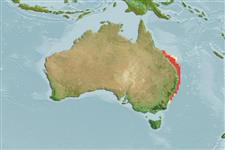Environment: milieu / climate zone / depth range / distribution range
Ekologi
marina revassocierade; djupintervall 27 - 80 m (Ref. 5222). Temperate; 20°S - 36°S, 135°E - 156°E (Ref. 5222)
Western Pacific: endemic to Australia, from southern Queensland (One Tree Islands, Great Barrier Reef at 23°30'S) to Bateman's Bay (35°44'S), New South Wales. One specimen was reported from Kangaroo Islands, South Australia.
Size / Vikt / Age
Maturity: Lm ? range ? - ? cm
Max length : 61.0 cm TL hane/ej könsbestämd; (Ref. 5222); publicerad maxvikt: 5.5 kg (Ref. 4787)
Taggstrålar i ryggfenan (totalt): 11; Mjukstrålar i ryggfenan (totalt): 15-17; Taggstrålar i analfenan 3; Mjukstrålar i analfenan: 8. Interorbital area convex, Almost straight dorsal profile; preopercle sub angular, serrae slightly enlarged; upper edge of the operculum almost straight; nostrils subequal; maxilla reaches to or slightly beyond vertical at posterior edge of the eye. Pectoral fins fleshy; pelvic fins not reaching anus, except in small individuals. Pyloric caeca 11. Characterized further by the following: buff body, covered with close-set wavy longitudinal brownish orange, golden brown or reddish brown stripes; some stripes broken into series of small spots; pale greyish brown head, covered with small spots same as on the body; orange-brown maxillary streak; pale fin rays, with small brown spots, inter-radial membranes dark brown; narrow yellow margins on median fins; pectoral fins diffusely yellow distally (Ref. 89707).
Inhabits coral reefs (Ref. 58652) and rocky areas. It is an active swimmer that will leave the bottom to take a floating bait.
Life cycle and mating behavior
Könsmognad | Reproduktion | Lek | Ägg | Fecundity | Larver
Heemstra, P.C. and J.E. Randall, 1993. FAO Species Catalogue. Vol. 16. Groupers of the world (family Serranidae, subfamily Epinephelinae). An annotated and illustrated catalogue of the grouper, rockcod, hind, coral grouper and lyretail species known to date. Rome: FAO. FAO Fish. Synop. 125(16):382 p. (Ref. 5222)
IUCN Red List Status (Ref. 130435)
Threat to humans
Harmless
Human uses
Fiskeri: kommersiell
Ytterligare information
PopulärnamnsynonymerMetabolikPredatorerEkotoxikologiReproduktionKönsmognadLekSpawning aggregationFecundityÄggEgg development
referenserVattenbrukVattenbruksprofilAvelslinjerGenetikElectrophoresesÄrftlighetSjukdomarBehandlingNutrientsMass conversion
MedarbetareBilderStamps, Coins Misc.LjudCiguateraHastighetSimsättGälytaOtolithsHjärnstorlekSyn
Verktyg
Special reports
Download XML
Internet-källor
Estimates based on models
Preferred temperature (Ref.
123201): 21.1 - 25.1, mean 24.4 °C (based on 14 cells).
Phylogenetic diversity index (Ref.
82804): PD
50 = 0.5000 [Uniqueness, from 0.5 = low to 2.0 = high].
Bayesian length-weight: a=0.01175 (0.00571 - 0.02419), b=3.04 (2.88 - 3.20), in cm total length, based on LWR estimates for this Genus-body shape (Ref.
93245).
Trofisk nivå (Ref.
69278): 3.9 ±0.5 se; based on size and trophs of closest relatives
Resiliens (Ref.
120179): Mellan, lägsta populationsfördubblingstid 1,4-4,4 år (Preliminary K or Fecundity.).
Fishing Vulnerability (Ref.
59153): Moderate vulnerability (44 of 100).
Nutrients (Ref.
124155): Calcium = 8.02 [2.94, 18.42] mg/100g; Iron = 0.161 [0.081, 0.370] mg/100g; Protein = 18.8 [17.2, 20.3] %; Omega3 = 0.316 [0.164, 0.585] g/100g; Selenium = 8.56 [3.88, 18.88] μg/100g; VitaminA = 117 [25, 535] μg/100g; Zinc = 0.611 [0.387, 0.943] mg/100g (wet weight);
